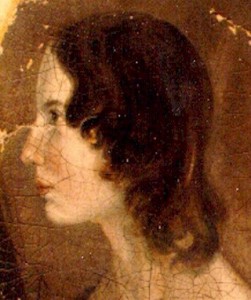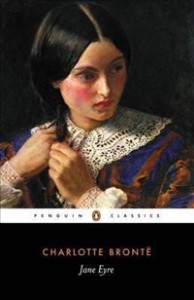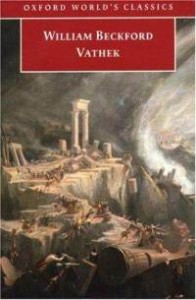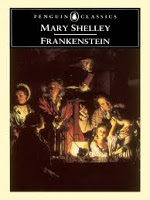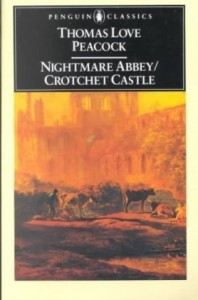Introduction
‘Wuthering Heights’, by Emily Bronte, is one of most famous works of English language fiction from the Nineteenth Century. Subtle as a sledgehammer, it is a powerful example of emotional writing that, although it depicts wild people in a wild place, is nevertheless brilliantly controlled and meticulously planned. It includes vivid character studies in psychological motivation, and the written style features an impressive collection of stylistic techniques. All in all, a perfect book to learn from.
But it’s also a book to enjoy. Once you get used to the narrators (there are several) and the language that they use, it’s a powerful story of love and revenge, of passion and humanity lost and regained.
Watch ‘Wuthering Heights’ HERE!
Emily Bronte (below) was one of three sisters, all of whom wrote published novels that have remained some of the most important of the Nineteenth Century and which are still read today. See the end of this page for more details about them.
♠
Introductory Task
First of all, we need to find out more about the time in which the book was written. Emily Bronte was writing in the 1840’s, but the novel is set in the late Eighteenth Century, finishing in 1802. It is set in a rural part of Yorkshire, in the north-east of England – wild and windswept. Location and period are both important to our understanding of this novel. It’s also always interesting to find out a little more about the writer and what might have influenced her. So we need to do some background research.
There are seven topics
Byronic Hero and the Romantics
define, explain the Romantic movement that spawned them, who are some famous ones? what are their characteristics? what is interesting about them considering the time period.
Gothic Literature
where did this come from? what are the attributes of this form? what are some famous examples? why did the public like them?
The Yorkshire Moors
where are they located? what sets them apart as a landscape? what are the characteristics?
Emily Bronte
what was her early life like? what kind of stories did she write? what was shocking about her authoring this novel? how did she come up with the idea?
Victorian Morality
how were proper young ladies expected to behave? how were proper young men expected to behave?
Victorian Marriage
at what age did girl marry? boys? where did they live? what was the family life like?
Village life/rural life in the moors
what was village life like in the Victorian era? what had industrialization done? what jobs were there for women?
You will design and present posters on your chosen topic. You will be given some lesson time for this. Watch Veracross for dates.
Here are the instructions as found on Veracross.
Here is an interesting link to tell you more – in a not-too-serious way – about the whole tradition of Gothic literature that Bronte would have been very familiar with.
♣
Reading Tasks
As you read the book, use the following documents to help your understanding. Remember, all notes should be made in your notebooks; these documents are best printed out and stuck into your notebooks so that all the information you need to help you with assessed tasks is in one place.
It is also important that you complete a guided reading of Wuthering Heights. so that you think about what you are reading, as you read. Use the guided reading questions to help you along. Please ensure that you answer each of them in detail; this will not only support your reading, but also serve as a good reminder as we study the text in class.
This first document explains a little more about the most famous Gothic element in ‘Wuthering Heights’. Download the song ‘Wuthering Heights’ by Kate Bush to play as you work with this!
Wuthering Heights Gothic Elements
We will focus on Chapter 3 as an example of close commentary on a text. This is a skill that you will need to develop for your DP Language A courses. Use these documents to help. See Veracross for further information and dates.
Chapter 3 Cathy at the window (vocab) Cathy at window (written task)
Finally, you are aware of the importance of quotes as evidence to support the points you make in an analytical essay. Below are some document that will help you assemble an impressive collection of quotes that you can use for some of the main characters.
Cathy Heathcliff Character Study Heathcliff Quotes Heathcliff v Edgar Lockwood as Narrator Quotes
And one for the imagery used in the book.
♥
Assessed Tasks
1. Diary
You will write in the character of one of the main protagonists in the novel (you have a choice, some from the first generation, some from the second). See the attached instructions (which also appear on Veracross).
Wuthering Heights Diary Instructions
Watch Veracross for dates.
2. Student-Led Seminar
These seminers are a chance to learn from each other. We will do these for some units in Grade 10 as a useful way of sharing knowledge. Seminars are also an essential part of DP and university course work, so they are something you will need to get accustomed to. See the attached instructions (which also appear on Veracross).
Wuthering Heights Student-Led Seminar Instructions
Below are the assessment criteria we will use.
Assessment Criteria (Student Led Seminar)
3. Essay
Your final task will be a literary essay. More details will be given at the time. It will be done in class, either in a regular period or as part of your semester exams.
♦
Further Reading
Emily Bronte was also a published poet. Here is one of her poems. What effect does the surrounding countryside have on her?
From the Bronte family, you might also enjoy novels by Emily’s sisters Charlotte and Anne.
Some ‘Gothic’ works that influenced Emily Bronte include these…
And, of course…
A famous parody of ‘Gothic’ literature, that Emily Bronte would have read, is…
And finally, though it came long after Emily Bronte and the end of the Gothic movement, here is the most famous ‘Gothic’ novel of all…
That is the end of this unit. Please leave a comment below.
♠♣♥♦

